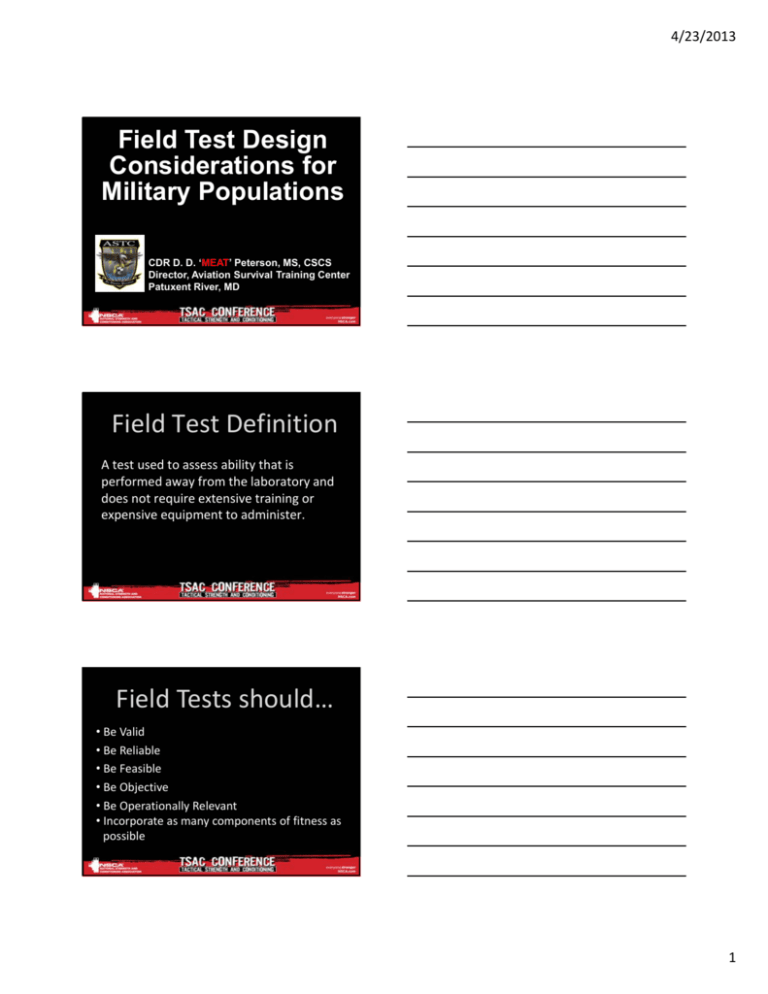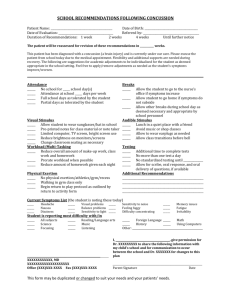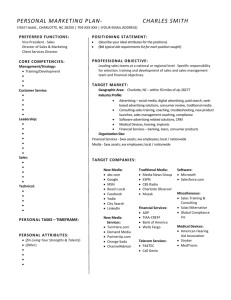Field Test Design Considerations For Military Populations
advertisement

4/23/2013 Field Test Design Considerations for Military Populations CDR D. D. ‘MEAT’ Peterson, MS, CSCS Director, Aviation Survival Training Center Patuxent River, MD Field Test Definition A test used to assess ability that is performed away from the laboratory and does not require extensive training or expensive equipment to administer. Field Tests should… • Be Valid • Be Reliable • Be Feasible • Be Objective • Be Operationally Relevant • Incorporate as many components of fitness as possible 1 4/23/2013 Components of Physical Fitness Health Related: ‒ Cardiovascular Fitness ‒ Muscular Endurance ‒ Muscular Strength ‒ Flexibility ‒ Body Composition Skill Related: ‒ Speed ‒ Agility ‒ Power ‒ Coordination ‒ Balance ‒ Reaction Time Field Test Order • Non‐fatiguing tests • Agility tests • Maximum power / strength • Sprint tests • Muscular endurance • Anaerobic capacity • Aerobic capacity 2 4/23/2013 Skin Fold Caliper • Naval Health Research Center (NHRC) conducted a feasibility study with 38 CFLs • After six one‐hour training sessions (75 measurements) only 24% were proficient DoD Instruction 1308.3. • Establish percent body fat standards using the circumference‐based method. • Circumference‐based methods are inextricably linked to military body fat standards and have been carefully evaluated against other methods and for applicability to Service members. Accuracy of Body Fat Techniques Method Std. Error (%) Autopsy .01 Hydrostatic Weight* Circumference (Navy) Calipers* 1.5 - 3.0 3.5 3.0 - 5.0 Height / Weight 5.0 Bio-impedance* 4.0 - 5.0 Near Infrared 7.0 * Research Environment 9 3 4/23/2013 Circumference Measurements NIH Circumference Site DoD Circumference Sites Health‐Related Waist Circumference Criteria National Institutes of Health (NIH): • Iliac Crest • Males: 40 in. • Females: 35 in. Naval Health Research Center (NHRC): • Mason and Katzmarkzyk (2009) • Umbilicus • Males: 40.2 in. • Females: 36 in. Revised % Body Fat Equation for Females Current Male Equation: • % Body Fat = 86.010 x log10(abdomen ‐ neck) ‐ 70.041 x log10(height) + 36.76 Current Female Equation: • % Body Fat = 163.205 x log10(waist + hip ‐ neck) ‐ 97.684 x log10(height) ‐ 78.387 Proposed Female Equation: • % Body Fat = 148.489 x log10(abdomen + hip ‐ neck) ‐ 87.581 x log10(height) ‐ 74.980 4 4/23/2013 Figure 1. Relationship between % fat estimated using the new equation and that estimated from the current equation. The solid red line is the regression of old on new. The dashed line is the line of identity. Figure 2. Relationship between % fat estimated using the new equation and that measured from underwater weighing and the Siri equation. The solid red line is the regression of Siri fat on that estimated from the new equation. Dashed red lines and the 95% confidence intervals of the regression. 1# True Negatives / (# True Negatives + # False Positives) 2# True Positives / (# True Positives + # False Negatives) 5 4/23/2013 DoD Instruction 1308.3 • Military Services shall develop and use physical fitness tests (PFTs) that evaluate aerobic capacity, muscular strength, and muscular endurance. • PFTs shall assess baseline generalized fitness and not represent mission specific fitness demands. 1985 Robertson & Trent Study • Numerous shipboard and other Naval tasks require great physical strength. However, few field batteries exist to adequately assess muscular strength. • ~ 84% of Navy shipboard tasks can be categorized into three basic movement patterns ‒ Lifting ‒ Carrying ‒ Pulling Testing should depict sport… 6 4/23/2013 Common Navy Tasks General Fitness Categories Specific Tasks / Modalities Muscular Strength Muscular Endurance Explosive Power (e.g., throwing, jumping) Speed / Agility Flexibility Officer XX XX XX X X Enlisted XXX XX XX XX X Running (Short Distance) Running (Long Distance) Walking Lifting Carrying Pulling Pushing XX X XX XX XX XX X XX XX X XXX XXX XXX XXX XX XX Sitting Shipborne Aviation Officer XX XX X X Enlisted XXX XX XX X X X X XX X X X X XX X XX X XX XX XX XX XX XX Administrative / Clinical Officer X X X X Enlisted X X X X X X X XX X X X X XXX X X X XX X X X X XXX Special Warfare (e.g., SEALs, Divers, etc.) Officer XXX XXX XXX XXX XX XXX X XXX XXX XXX XXX XXX Enlisted XXX XXX XXX XXX XX XXX X XXX XXX XXX XXX XXX X Totals 18 16 15 13 10 15 8 19 16 16 16 14 16 x = Low Demand xx = Moderate Demand X xxx = High Demand Developing a Test • Define what you want to measure • Research to find any existing tests • Modify / develop official testing procedures • Determine appropriate scoring system • Pilot test the test, scoring system, and procedures • Evaluate, modify, and retest • Develop norms Bishop, P. (2008). Measurement and Evaluation in physical activity applications. Scottsdale, AZ: Holcomb Hathaway, Publishers, Inc. Potential Field Test Events Upper Body Flexibility Balance Agility Anaerobic Power Speed Lower Body Core Body Circumference (2‐site for Males; 3‐site for Females) 3‐Site Skin‐Fold Body Composition Shoulder Flexibility Test Sit‐Reach ‐ ‐ Stork Stand Test Modified Bass ‐ ‐ ‐ 3‐Cone Drill Pro‐Agility NSCA T‐Test Peterson Agility Test Overhead Medicine Ball Throw Underhand Medicine Ball Throw Standing Long Jump Vertical Jump ‐ ‐ 40‐yd Sprint ¾ Court Sprint ‐ Muscular Strength Push‐Pull Dynamometer Test Leg‐Hip Dynamometer ‐ Muscular Endurance Pull‐Ups Modified Cadence Push‐Ups Wall Squat Quad Squat Jumps Plank V‐Sit Anaerobic Capacity ‐ 60‐yd Shuttle 300‐yd Shuttle 400‐m Sprint 800‐m ‐ Aerobic Endurance ‐ 3‐min Celtic Run 1600‐m 1.5‐mi. Run ‐ 7 4/23/2013 Muscular Strength Tests • No one test considered the ‘gold standard’ • Test selection should be based off: – – – – – Subject population Specificity to respective sport Available equipment Ease of data analysis and interpretation Time to administer 23 Muscular Endurance Tests • Tests that use reps to failure relate strongly to max muscular strength • Difficult to determine time hold requirement for isometric field tests – Flexed Arm Hang – Plank • Tests using a constant cadence lack external validity – USCG Cadence Push‐Up – ACSM Partial Curl‐Up 24 8 4/23/2013 Aerobic Power • Testing applicable to only long distance athletes • Lower priority for anaerobic athletes • Although not ideal for anaerobic athletes, aerobic power training does help facilitate a faster recovery • Often used in lieu of anaerobic testing as more options are available 25 Anaerobic Power Tests • Regarded by many as the best index of: ‒ coordinated human movement ‒ chronic function or dysfunction ‒ acute deficiency • Encompasses both speed and strength • Principal training objective • Represents the ability to rapidly generate force • Must account for differences in body mass 26 Speed / Agility Tests • Distance for speed tests should be 200m or less • Agility tests also incorporates: ‒ Balance / Coordination / Reactive component ‒ Muscular / cardiorespiratory endurance • Agility tests should be 20 seconds or less • Additional considerations for agility tests: – Environmental factors (e.g., humidity, temperature, etc.) – Hydration – Rest periods 27 9 4/23/2013 Criterion‐Referenced vs. Norm Referenced Tests US Army Airborne School APFT Requirements Event Male (17‐21 y/o) Push‐Ups 42 Female (17‐21 y/o) 19 Sit‐Ups 53 53 2‐Mile Run 15:54 18:54 US Army Ranger Physical Fitness Test Push‐Ups Sit‐Ups Chin‐Ups 5‐Mile Run 49+ 59+ 6+ <40:00 Peterson Agility Test • Pro’s: – Involves multiple movements • Forward sprinting • Lateral shuffle • Backpedal – Utilizes multiple energy systems • Phosphagen • Fast Glycolysis • Con’s – New test / No established performance norms – Surface considerations – Familiarization period required 10 4/23/2013 V‐Sit • Pro’s: – Safer than traditional Sit‐Ups – Specificity principle • Body position • Muscles trained • Con’s: – Require partner / foot hold – Poor reliability – Subjective Quad • Pro’s: – Lower body muscular endurance test – Starting position for a wide variety of fundamental movements • Bear crawl • Quad to Push‐Up • Con’s: – Performance gains are angle specific – Poor reliability – Subjective 11 4/23/2013 3‐Minute Celtic Run • Pro’s: – Shorter and easier test to administer – More operationally relevant • Con’s: – Court length varies • NBA: 94 ft • High School: 84 ft • Elementary: 74 ft – Not recommended for precise measure – Increased risk for injury Proposed Military Field Test Body Composition Analysis (BCA): • DoD Circumference Measurements • Waist Circumference – 40 in (Male) / 36 in. (Female) Physical Readiness Test: • Plank • Pull‐Ups • 800‐m Sprint 12 4/23/2013 ALMAR 046/12 • Effective 01 JAN 2014, flexed‐arm hang will be replaced with the pull‐up – – – – – – 8 pull‐ups = 100 points 7 pull‐ups = 95 points 6 pull‐ups = 85 points 5 pull‐ups = 75 points 4 pull‐ups = 65 points 3 pull‐ups = 40 points 37 Recommended Exercises for Military Conditioning Programs Resistance Training: • • • • Bench Press Squat Deadlift Push‐Press Plyometrics: • • • • Squat Jumps Box Jumps Overhead Medicine Ball Throws Wall Ball Shots Balance: • • Stork Stand Bass Test Sprint / Agility: • • • • • • 40‐yd Dash 400‐m Peterson Agility Test 60‐yd Shuttle 300‐yd Shuttle 3‐min Celtic Run Muscular Endurance / Isometric: • • • • • • Cadence Push‐Ups V‐Sit Side Planks Glute Bridges Quad Wall Squats CDR D. D. ‘MEAT’ Peterson Director, ASTC Patuxent River 22025 Fortin Circle, Bldg 2165 NAS Patuxent River, MD 20670‐1133 E: david.peterson3@med.navy.mil W: (301) 342‐0723, DSN 342 13 4/23/2013 Questions? 14






